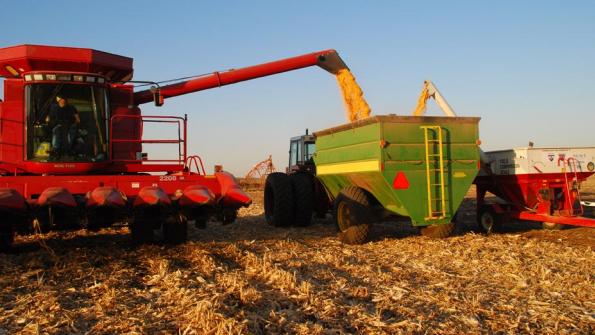November 22, 2011

As farmers near completion of the 2011 harvest, Ohio State University corn production expert Peter Thomison says that despite weather challenges at planting and harvest, yields were largely better than expected across Ohio.
"Yields have been surprisingly good, even in those areas of the state that were dry, such as the areas along the Indiana border that got really dry weather, and we've been surprised at how strong yields have held," says Thomison, an OSU Extension corn specialist and professor of horticulture and crop science. "On the other hand, we have growers who planted in the early weeks of June who got ideal conditions after planting and they're seeing yields of 200 bushels or more. Corn planted in early June wouldn't normally be expected to yield that well."
Thomison says the key for many parts of Ohio was optimal corn producing conditions after the late planting was completed.
While university research often suggests a yield boost from planting earlier, he said the key benefit to early planting is consistency.
"Corn yields are typically more consistent when we plant in late April and early May, and we see more variability in yield potential the later we plant," he explains. "That is a function of the impact of weather conditions on late-planted corn. If the plant is exposed to especially hot, dry conditions in August with a plant that didn't flower until a month later than normal, that can be a disaster."
For many parts of Ohio, on the other hand, Thomison says 2011 was marked by timely rains "that made all the difference in the world."
He says that while replicated-trial studies are not yet available on the consistency of yields in early vs. late-planted conditions, his observations and anecdotal data suggest that later-planted corn is simply more susceptible to environmental stressors like extreme dryness or excessive heat.
"Some people still remember 2002 when we had a lot of corn planted after June 1 and we ran into a major drought and had terrible yields," Thomison points out. "Late-planted corn can yield well, if the environmental conditions are right. In a year like 2002 when it basically stopped raining after June, you can have a debacle, but we didn't see that this year."
The USDA's National Agricultural Statistics Service (NASS) reported that as of Sunday, Nov. 21, farmers had harvested 69% of Ohio's corn crop and 93% of the state's soybeans. Last year at the same point in the season, harvest of both crops was statistically finished.
Thomison says the concern now for farmers with unharvested corn is the potential for yield loss the longer the crop stays in the field.
"Generally what we see from our studies is that we start to see yield losses in mid-November, when we delay harvest as late as December or beyond, that's when we start to see yield losses," he said. "We can get away with harvest delays up to that point, but once we get into December, the crop starts to deteriorate more rapidly."
For many producers, the relative wetness of the grain yet to be harvested is one reason they might choose to let corn stand in the field. Thomison cautions, however, that at this point in the season, grain is more or less finished drying through non-mechanical means.
"The corn isn't going to dry down much further. A lot of growers are surprised at how good their yields are, but they are very disappointed with how wet the corn is coming out of the field. After the middle of November, corn doesn't dry down much more in the field."
Another concern that might keep harvest from wrapping up more quickly is the impact – literally and figuratively – of machinery moving across wet soils. Thomison says field damage from compaction is a significant concern when wet conditions persist during a late harvest.
NASS says precipitation across Ohio during the week ending Nov. 21 averaged 1.51 in., 0.86 in. above normal. In its rating of soil moisture, the agency said Ohio soils were rated 48% adequate and 52% surplus at the topsoil level.
Despite the seemingly numerous challenges facing farmers throughout the 2011 growing season, Thomison says one fact remains: Most farmers harvested, or are harvesting, a good crop.
"What it boils down to, very simply, is rainfall and temperatures. If we get timely rains during the pollination and grain-fill periods, you have the potential for high yields."
You May Also Like




